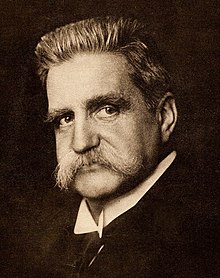Election to the Swedish parliament in 1921
Election to the Swedish parliament in 1921
%
40
30th
20th
10
0
36.22
25.79
18.69
11.04
4.61
3.23
0.42
Gains and losses
compared to 1920
% p
8th
6th
4th
2
0
-2
-4
+6.57
-2.02
-3.09
-3.08
-1.78
+3.23
+0.16
Distribution of seats
A total of 230 seats
- SKP : 7
- SSV : 6
- S : 93
- B : 21
- FL : 41
- AV : 62

Election winner Hjalmar Branting received the Nobel Peace Prize in 1921. He was Prime Minister of Sweden three times:
1st from March 1920 to October 1920
2nd from October 1921 to April 1923
3rd from October 1924 to January 1925
1st from March 1920 to October 1920
2nd from October 1921 to April 1923
3rd from October 1924 to January 1925
In September 1921 there was an election for the Second Chamber of the Swedish Reichstag . It was the first election in Sweden where women also had the right to vote.
Before the elections, the Swedish Social Democratic Left Party had swung into the ideological line of the Russian-dominated Communist International and renamed itself the Swedish Communist Party. A minority, who did not want to support this, then founded a new party in 1921 under the old name Social Democratic Left Party of Sweden . The new party only ran for this election and united with the Social Democrats in 1923.
The Bauernbund merged with the Reich Association of Farmers in 1921 under the name of the Bauernbund.
| Political party | % Votes |
Change to 1920 |
|---|---|---|
|
Social Democrats Sveriges socialdemokratiska arbetareparti |
36.2% | + 6.5% |
|
Conservative Allmänna valmansförbundet (General Electoral Association) |
25.8% | −2.0% |
|
Liberale Liberala samlingspartiet (Liberal Gathering Party) |
18.7% | −3.1% |
|
Bondeförbundet farmers' union |
11.0% | −3.1% |
|
Communists Sveriges kommunistiska parti |
4.6% | −1.8% |
|
Swedish Social Democratic Left Party Sverges socialdemokratiska vänsterparti |
3.2% | + 3.2% |
| Other parties | 0.4% | + 0.1% |